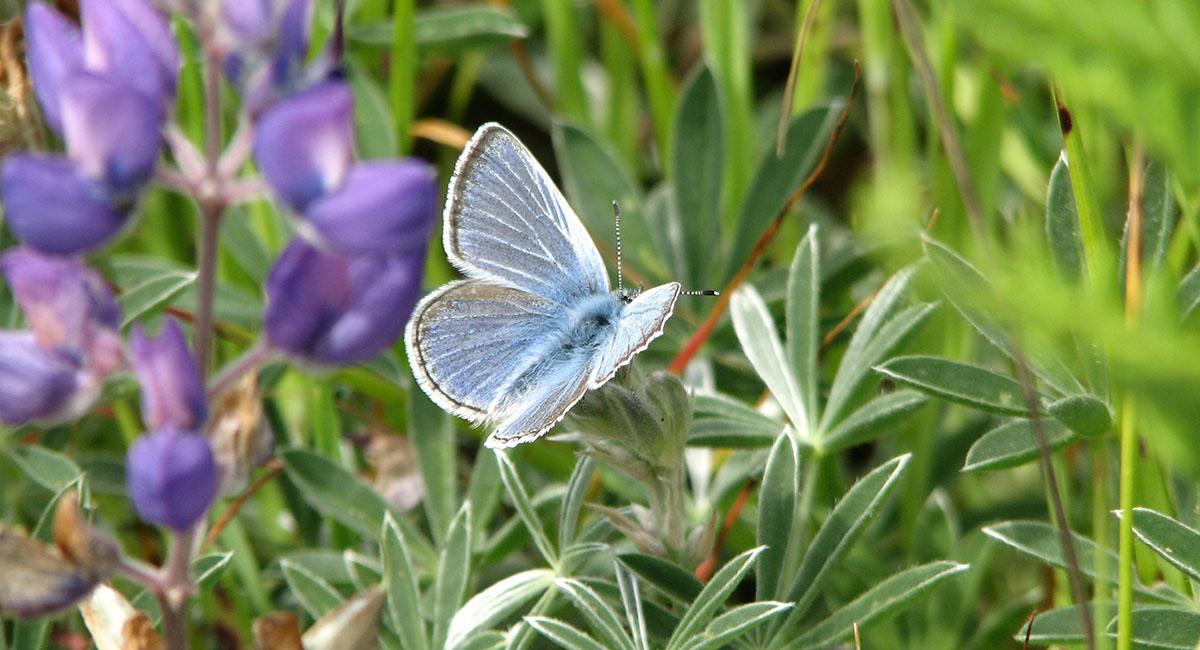Your parks need you now
Your support helps fight climate change and promote park sustainability—please give now.

This winter the Golden Gate National Parks will be planting over a thousand lupines, the host plant of the mission blue butterfly. As we begin this restoration work to help this endangered species, I can’t help but reflect on all that I have learned from the mission blue butterfly.
1) There is wonder and mystery hiding under ever leaf.
The first time I saw a mission blue butterfly caterpillar, it was in February. Christina Crooker, a restoration manager in the park, had to point the caterpillar out to me. We were out pulling invasive French broom that was taking over the butterflies’ habitat. Christina and I were crouched down on our knees on a grassy hill next to a silvery lupine. Delicately holding the lupine branch, she pointed to the underside of the leaf. After repeated attempts, I finally saw an inch-long green caterpillar camouflaged against the lupine it clung to.
Then, as I got up from my crouched position and looked once again across the grassy hillside we were working on, my perspective changed. How many hidden caterpillars crawled across this landscape, I wondered? How many mysteries had I overlooked in this park?
2) Life is fleeting, but it makes life more precious and beautiful.
The first time I saw a mission blue butterfly on the wing, it was in May. I wasn’t sure it was actually the right butterfly. The acmon blue butterfly looks just like it, but has a bit of orange color on the wing.
As a butterfly suddenly fluttered by, I quickly strained my eyes to see the three rows of black dots outlined in white on the underside of the wing. Yes: mission blue. The challenge of confirming this sighting made the eventual confirmation so much more rewarding. Just as suddenly as the butterfly appeared, it was gone again. This made the sighting so much more memorable because it was so fleeting.
3) When life gets hard, take a nap.
For eight months of the year, a person will be hard-pressed to see a mission blue butterfly caterpillar in the park. That is because they are in a hibernation-like state called diapause.
Life on the grassy slopes of California is hard. Wind from the ocean blows cold and strong, and during the summer there is no water so all the lupines dry up. The mission blue butterfly has learned to adapt to these difficult times by going to sleep.
When life gets overwhelming for me, I often take a nap. I am always surprised how much better I will feel when I wake up.
4) What you can’t do alone, you can do together.
During this stage of diapause, the mission blue butterfly caterpillar is defenseless from predators that easily can find the caterpillar’s motionless, soft body. Yet, through a mutually beneficial relationship with the native ants, the caterpillar does enjoy some protection. While the native ants protect the caterpillar from predators, the caterpillar in turn has evolved a special organ that feeds the ants a sweet substance called “honeydew!”
The mission blue butterfly has taught me that by working together we can overcome obstacles that we cannot overcome alone. I reflect on all of the relationships in my life, and strive to find mutually beneficial relationships at work and in my social circle.
I can’t help but think about all the beneficial relationships that keep the parks beautiful and healthy; there is the mutualistic relationship between Golden Gate National Parks and the Parks Conservancy, and the relationships between the parks and the communities that surround the parks. There is also the special relationship between the Parks Conservancy and the California Garden Clubs Inc. (CGCI). Over the past three years, CGCI has raised money from individual donations to grow over a thousand lupines for the mission blue butterfly.
5) Change happens.
In the springtime the grass is green, lupines are growing, and the hungry caterpillar awakes from diapause. It eats for four to five weeks and then gets enough energy to spin a chrysalis.
Inside the chrysalis the entire caterpillar is changing. You can think of this metamorphosis like recycling. A lot of the caterpillar breaks down into imaginal cells that can become any type of cell, and slowly the mission blue caterpillar is put back together as an Imago, or adult butterfly.
In the park, we strive for the restoration of ecosystems to be as elegant as this metamorphosis. This winter you will see a thousand lupines go into the ground at Milagra Ridge and Wolfback Ridge, two sites in the Golden Gate National Parks in San Mateo County and Marin, respectively. These lupines will be planted to create habitat corridors between existing isolated butterfly populations. By planting these corridors, the park hopes to increase the amount of butterflies and expand their habitat—creating a change that is as beautiful as the butterflies themselves.
Photo by Rachel Lorenz
Your support helps fight climate change and promote park sustainability—please give now.